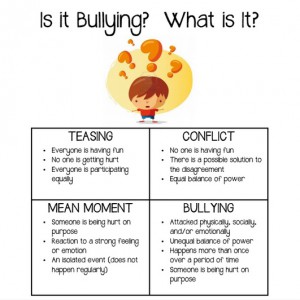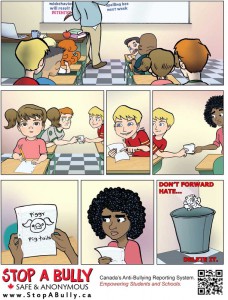Why I Will Integrate Lessons On Relational Aggression Into My EFL Classroom:Resources To Consider
After teaching English to Senior High School students for fifteen years, I had a one-year shift to Primary School, which proved really educational for me. Among other things, it gave me great insight into how roles and relations shape up from an early age. This experience together with some sad incidents in my neighbourhood’s playgrounds set me about searching and reading about relational aggression, a type of bullying.
Open and direct forms of bullying like insults, pushing around or hitting may be easy to detect and acknowledge but there are sneakier ones that cause as much pain and even greater, because they are discrete, subtle and often go unnoticed by adults and even other peers. These forms of bullying target the social sphere of the victim and are all described within the term of “Relational Aggression”.
According to the article It’s “Mean,” But What Does It Mean to Adolescents? RelationalAggression Described by Victims, Aggressors, and Their Peers (published by Journal of Adolescent Research http://jar.sagepub.com/cgi/content/abstract/25/2/175) relational aggression includes “negative social behaviors that are intended to harm relationships, social roles, and/or social standing (Crick & Grotpeter, 1995).” These behaviours may come up as “exclusion from activities or a desired friendship group, the silent treatment, and spreading false rumors.”
The targeted child often goes through gossip, purposeful avoidance and telling peers not to associate with them, backstabbing, using code names to talk about others, whispering, etc. What makes such behaviors even more agitating is the fact that they often come from assumed friends.
Relationally aggressive behavior worries and disquiets me the most, for a number of reasons. First, it goes beyond overt aggressiveness; it is carefully organized and disguised so as not to be easily detected. Second, research supports what I sensed through my own observations: relational aggression has been shown to deplete mental health and other aspects of child and adolescent socioemotional functioning, exactly like any other type of bullying. Third, it seems to be increasingly exercised by boys, too (it has been traditionally thought to be exercised by girls mostly). Finally, it becomes even more pervasive with the spreading use of social media so that it forms a whole separate type of bullying, that of cyberbullying.
Instead of letting this delicate subject for the anti-bullying school day, I think I can take advantage of its dynamic and inject it into my EFL classroom, as it can provide lots of material to discuss and work on.
Having these in mind, I collected some resources and lesson plans to get ideas and use. Some lesson plans refer to bullying prevention in general, but we can focus on the relationally aggressive behaviors according to the students’ age. It is important for the children to understand what relational bullying is and is not, because some practices, like gossiping for example, are thought to be Ok. I like the following chart which explains the differences between teasing, conflict, a mean moment and bullying, found at a relevant page of mssepp.blogspot.gr. There are more ideas and activities, too.
However, it shouldn’t slip our minds that these resources will only be beneficial if we practise empathy and teach respect on every day basis. This cannot be done in a one-day lesson. It takes time and effort on our part, because we must model, discuss, expect and acknowledge respect and every other positive behavior daily.
ACTIVITIES
class activities at bullyingnoway.gov.au
saying no to social bullying at tolerance.org
INFORMATION-RESOURCES-STEPS TO TAKE
antibullying teaching resources at beatbullying.org
article jar.sagepub.com
more than just mean girls at extension.umn.edu
Relational aggression at education.alberta.ca
relational aggression at wdmcs.org
relational bullying resources at wishschools.org
Resources at stopabully.ca
resources to prevent bullying at nea.org
Pennsylvania bullying prevention toolkit at safeschools.info
shunning and exclusion at kidpower.org
ten steps to stop and prevent bullying at nea.org
what to do about relational aggression at niot.org
why are those girls so mean at greatschools.org
LESSON PLANS
aggressors victims and bystanders at middle link of asdk12.org (lots of lesson plans and activities)
boys relational aggression curriculum at opheliaproject.org
Bullying.No way! lesson plans at bullyingnoway.gov.au
counter cyberbullying resources and lesson plans at mediasmarts.ca
Digital citizenship lessons at cybersmart.gov.au
Ethics lesson plan:Determining what is right and solving problems at brainpop.com
primary and middle school lesson plans at brainpop.com
relational bullying lesson plan at girlsguidetoendbullying.org
samples for different grades at bullyfree.com
students take on cyberbullying at niot.org
take a stand on bullying at learningtogive.org
SOME SUGGESTIONS
Visuals can easily be transformed into great prompters or even full lesson plans. For example, the following poster from stopabully.ca
is ideal for younger EFL learners and it can generate Present Tenses practice:
1) Speaking: Where are the children?What is the teacher doing? What are the two boys at the back doing? Have you ever seen or done something similar? Has this ever happened to you? How do you feel when…?
2) Writing: The students may write the poster story, add speech bubbles or write a diary entry from the point of view of the different students involved.
Have a look at a similar idea here.
Of course, videos are always engaging and they can be used as warm-ups. For instance, the following video can generate discussion on all aspects of relational aggression.
Let’s keep a positive mind and an active stand with the help of these resources. Remember to check copyright before using them!
photo credit: pixabay.com



